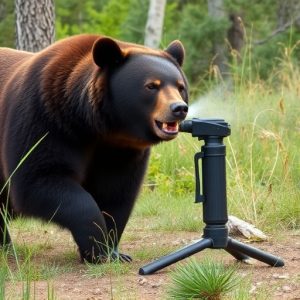Bear Spray Testing: Safety Guidelines for Effective Wilderness Protection
Bear spray is an effective personal safety measure for outdoor enthusiasts in bear-inhabited areas,…….
Bear spray is an effective personal safety measure for outdoor enthusiasts in bear-inhabited areas, but its success depends on safe usage practices. Rigorous testing assesses the spray's range, accuracy, and potency, providing data for user education. Proper storage, maintenance, and annual testing ensure optimal performance and safety. Adhering to Bear Spray Testing Safety Guidelines is crucial for responsible use and minimizing risks during encounters with wild bears.
“In wild landscapes where encounters with bears are a real possibility, bear spray stands as a powerful protection tool. This article delves into the intricacies of this life-saving device, beginning with an in-depth look at bear spray composition and its effectiveness. We explore essential safety guidelines for bear spray testing, ensuring users can deploy it accurately in high-stress situations. Furthermore, we provide best practices for storage and maintenance, emphasizing proper procedures according to Bear Spray Testing Safety Guidelines.”
- Understanding Bear Spray: Its Composition and Efficacy
- Bear Spray Testing: Safety Protocols for Effective Use
- Best Practices for Storing and Maintaining Your Bear Spray Device
Understanding Bear Spray: Its Composition and Efficacy
Bear spray is a powerful tool designed for personal safety while hiking, camping, or exploring wilderness areas known to be inhabited by bears. Comprising a mixture of capsaicin and other chemical agents, it acts as a deterrent by causing temporary blindness, coughing, and difficulty breathing in the target animal, allowing users to escape unharmed. The effectiveness of bear spray relies on proper usage and understanding of its range and application technique.
When considering bear spray as a wilderness protection device, it’s crucial to adhere to safety guidelines during testing and practice sessions. Users should familiarize themselves with the spray’s composition to anticipate its impact and understand the recommended safe distance for application. Following these safety measures ensures that individuals can effectively utilize bear spray when faced with potential encounters while minimizing risks associated with misuse or accidental exposure.
Bear Spray Testing: Safety Protocols for Effective Use
Bear spray testing is a crucial aspect of ensuring safety guidelines are followed for effective use in wilderness protection. Before deploying this device, it’s essential to conduct thorough trials under controlled conditions imitating real-world scenarios. These tests validate the spray’s performance, including its range, accuracy, and potency against potential bear encounters.
The safety protocols involved in bear spray testing are stringent to guarantee user safety and the effectiveness of the product. Participants in these tests are trained professionals who adhere to strict guidelines, wearing protective gear and following protocol to minimize any risks associated with the spray. The results from such testing play a vital role in educating users on proper usage, ensuring they have a reliable tool for self-defense against bears in various outdoor settings.
Best Practices for Storing and Maintaining Your Bear Spray Device
To ensure optimal performance and safety, proper storage and maintenance of your bear spray device are paramount. Keep it in an easily accessible yet secure location, preferably within a hard case or pouch designed specifically for outdoor gear. Avoid leaving it in direct sunlight or extreme temperatures; store it in a cool, dry place. Regularly inspect the can for any signs of damage, corrosion, or leakage, discarding it if any issues are found. Follow the manufacturer’s guidelines for best practice, including recommended storage temperature ranges and usage expiration dates.
Bear spray testing safety guidelines should always be followed to maintain effectiveness. Conduct routine tests at least once a year, mimicking actual bear encounters to ensure proper functionality. Keep your spray device away from heat sources or open flames, as these can compromise the integrity of the canister. Additionally, never leave it unattended in wild areas, and store it out of reach of children and pets. Regular cleaning with a soft cloth helps remove any residue, maintaining not just safety but also the spray’s range and accuracy.
In conclusion, bear spray is a valuable wilderness protection device that, when used correctly according to Bear Spray Testing safety guidelines, can significantly reduce the risk of bear encounters turning dangerous. By understanding its composition, testing protocols, and best practices for storage and maintenance, outdoor enthusiasts can ensure this tool remains reliable in critical moments. Remember, proper preparation and knowledge are key to a safe and enjoyable adventure in bear country.


